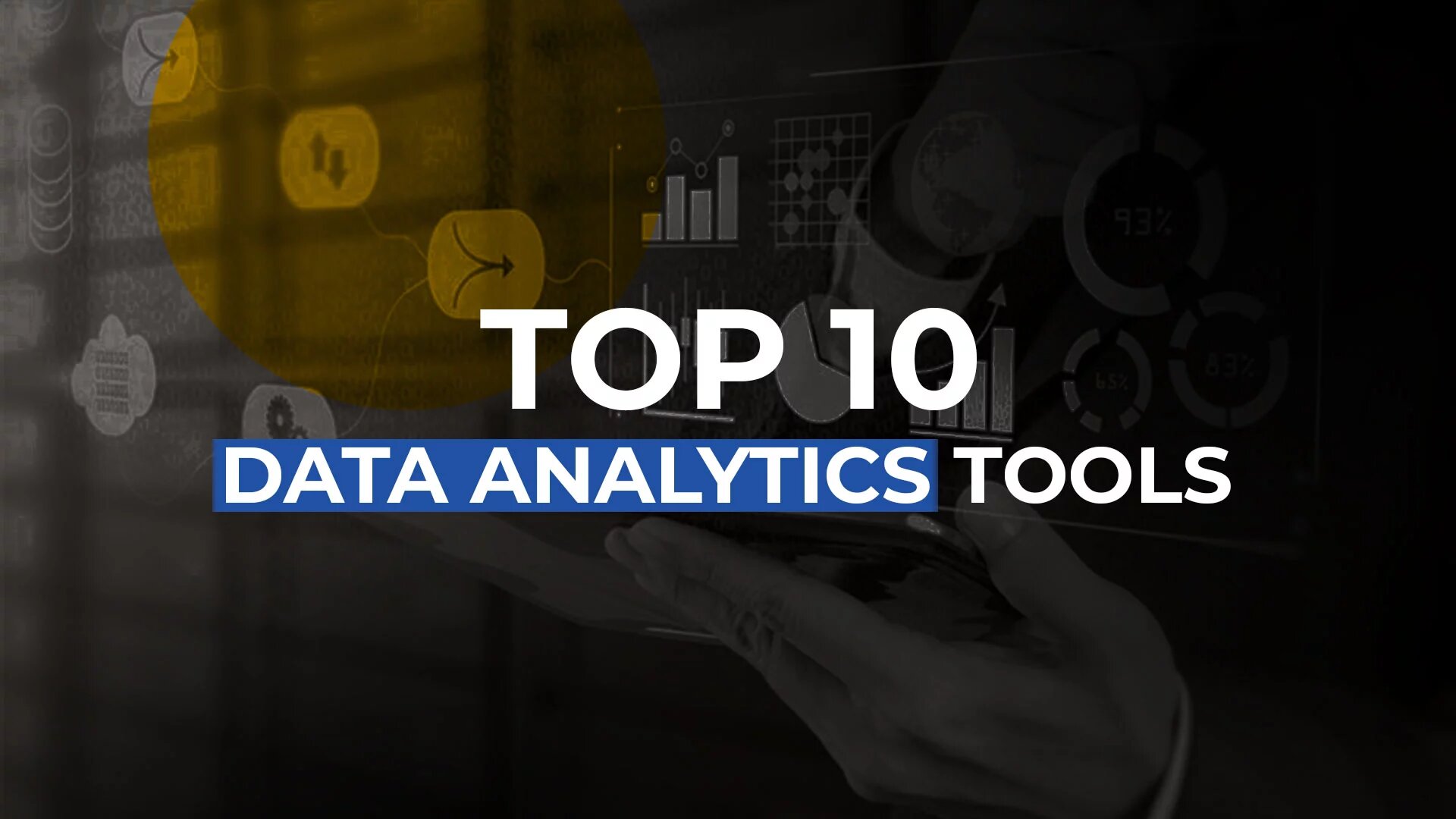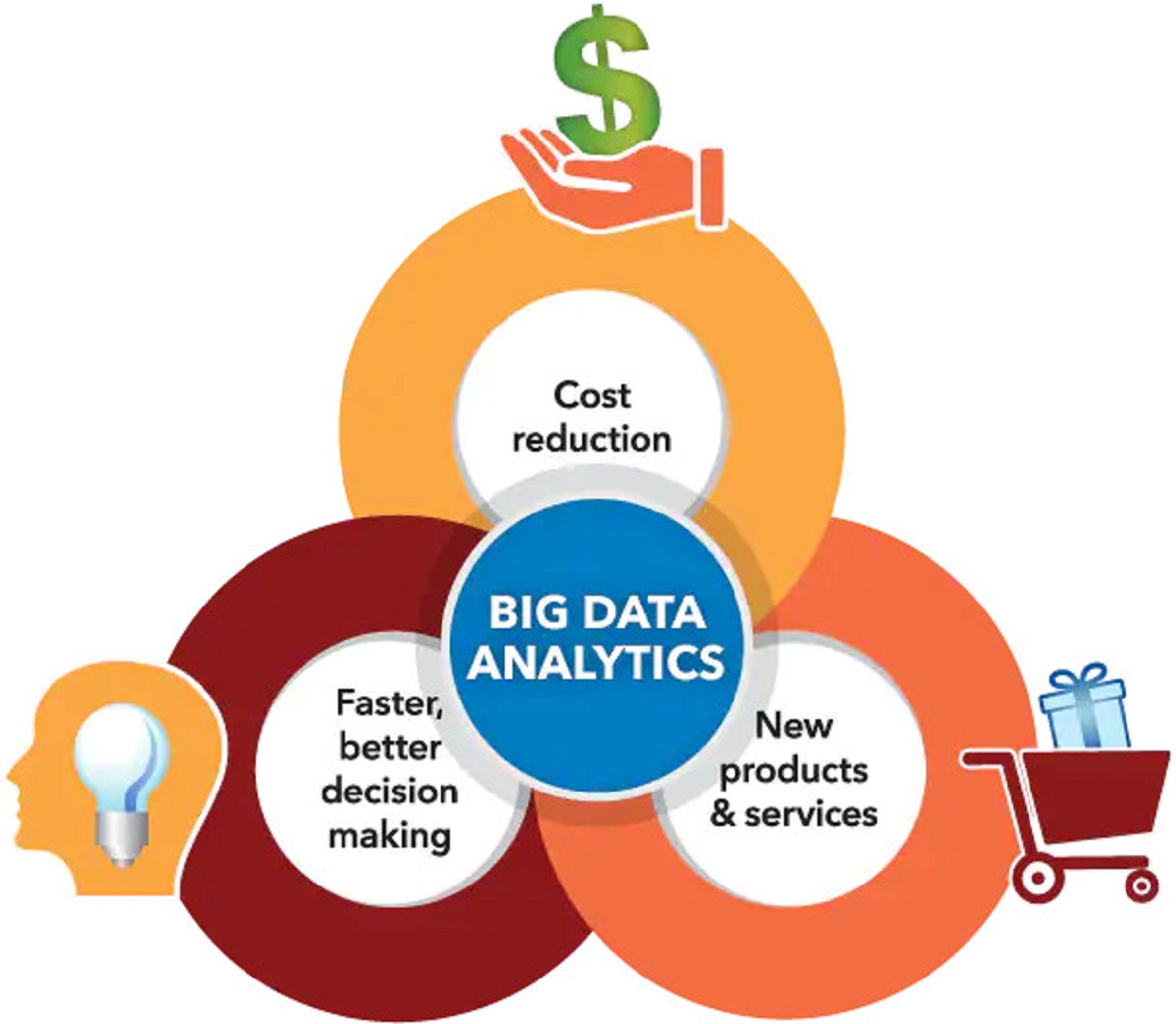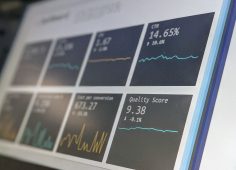Introduction
Welcome to the world of big data analytics tools! In today’s rapidly evolving digital landscape, businesses are generating vast amounts of data from various sources such as social media, websites, mobile apps, and IoT devices. This data, often referred to as “big data,” is valuable in providing insights and meaningful information for making informed business decisions.
Big data analytics tools are powerful technologies that enable organizations to extract, analyze, and interpret this massive volume of data. These tools provide a deep understanding of customer behavior, market trends, and operational efficiency, helping businesses gain a competitive edge.
With the exponential growth of data, organizations are increasingly relying on big data analytics tools to uncover hidden patterns, correlations, and insights that were once impossible to discern. These tools transform raw data into actionable intelligence, driving strategic decision-making and optimizing business processes.
The use of big data analytics tools has become essential for businesses across industries. From retail and finance to healthcare and manufacturing, organizations are leveraging these tools to gain valuable insights and enhance their operations.
In this article, we will explore the different types of big data analytics tools, their key features, benefits, and the challenges organizations face in implementing them. By the end, you will have a comprehensive understanding of how these tools can revolutionize your data analysis capabilities and propel your business forward.
Definition of Big Data Analytics Tools
Big data analytics tools are software applications and technologies that are specifically designed to process and analyze large and complex data sets, commonly known as big data. These tools utilize various algorithms, statistical models, and machine learning techniques to extract valuable insights, patterns, and trends from massive volumes of structured, semi-structured, and unstructured data.
By harnessing the capabilities of big data analytics tools, organizations can unlock the full potential of their data and gain a competitive advantage in the market. These tools enable businesses to identify significant correlations, anomalies, and trends that may not be apparent through traditional data analysis methods.
Big data analytics tools are equipped with sophisticated data processing capabilities that allow organizations to handle data in real-time or near real-time, ensuring timely and actionable insights. These tools support different stages of the data analytics lifecycle, including data collection, data cleaning, data transformation, data modeling, and data visualization.
Furthermore, big data analytics tools can handle diverse data types, including text, images, audio, video, time-series data, and more. They can also integrate with various data storage systems such as data warehouses, data lakes, and cloud platforms, ensuring seamless data handling and analysis.
One of the key characteristics of big data analytics tools is scalability. As the volume of data continues to grow rapidly, these tools can handle the increasing demands for data processing and analysis without compromising performance or efficiency.
The insights generated from big data analytics tools can be applied across various business functions and industries. From improving customer experience and optimizing marketing campaigns to enhancing supply chain management and fraud detection, these tools have the potential to revolutionize the way organizations operate and make informed decisions.
In summary, big data analytics tools are powerful technologies that enable organizations to make sense of large and complex data sets. By leveraging advanced algorithms and techniques, these tools provide valuable insights that drive strategic decision-making and enhance business performance.
Importance of Big Data Analytics Tools
Big data analytics tools play a crucial role in today’s data-driven business landscape. Here are some key reasons why these tools are of utmost importance:
1. Data-driven decision-making: Big data analytics tools enable organizations to make informed decisions based on data and evidence rather than relying on intuition or guesswork. These tools provide valuable insights and trends from large and complex data sets, empowering businesses to identify opportunities, mitigate risks, and optimize their operations.
2. Competitive advantage: In today’s competitive market, staying ahead of the curve is essential. Big data analytics tools provide businesses with the ability to analyze vast amounts of data quickly and efficiently, enabling them to identify emerging trends, predict customer needs, and make strategic decisions to gain a competitive edge over their rivals.
3. Improved customer understanding: Big data analytics tools extract meaningful insights from customer data, allowing businesses to gain a deep understanding of their target audience. By analyzing customer behavior, preferences, and purchase patterns, organizations can personalize their marketing efforts, enhance customer experience, and effectively target their products or services.
4. Enhanced operational efficiency: By analyzing operational data, big data analytics tools help organizations identify bottlenecks, streamline processes, and optimize operations. This leads to improved efficiency, cost savings, and better resource allocation. Companies can identify areas of improvement, reduce waste, and enhance productivity through data-driven insights derived from these tools.
5. Fraud detection and risk management: Big data analytics tools enable organizations to identify anomalies and patterns that indicate potential fraud or risks. By analyzing large volumes of transactional data, these tools can detect fraudulent activities, minimize financial losses, and enhance security measures to protect businesses and customers.
6. Innovation and new opportunities: Big data analytics tools can uncover hidden patterns, correlations, and insights that may not be evident through traditional analysis methods. This opens up new avenues for innovation, identifies untapped market opportunities, and enables companies to develop new products, services, and business models.
7. Real-time decision-making: With the processing power and speed of big data analytics tools, organizations can analyze data in real-time or near real-time. This allows businesses to respond quickly to changing market conditions, customer preferences, and operational requirements, enabling agile decision-making and proactive strategies.
Overall, big data analytics tools have become a vital resource for organizations aiming to leverage the power of data to gain a competitive edge, enhance operational efficiency, and make informed decisions that drive business growth and success.
Types of Big Data Analytics Tools
Big data analytics tools can be categorized into different types based on the specific analytics techniques and functionalities they offer. Here are the four main types of big data analytics tools:
1. Descriptive Analytics Tools: Descriptive analytics tools focus on summarizing and interpreting historical data to provide a comprehensive view of past events and trends. These tools help businesses understand what has happened by using techniques such as data aggregation, data visualization, and reporting. Descriptive analytics tools play a crucial role in data exploration, enabling organizations to gain insights into patterns, correlations, and anomalies present in their data.
2. Diagnostic Analytics Tools: Diagnostic analytics tools dig deeper into the data to understand why specific events or trends have occurred. These tools help identify the root causes of performance issues or incidents by using techniques such as data mining and drill-down analysis. Diagnostic analytics tools allow organizations to analyze past data and uncover the factors that have influenced certain outcomes, facilitating effective problem-solving and decision-making.
3. Predictive Analytics Tools: Predictive analytics tools utilize statistical models and machine learning algorithms to forecast future outcomes based on historical data. These tools analyze patterns and trends to identify potential future events or behaviors. Predictive analytics tools provide organizations with the ability to make data-driven predictions, anticipate customer needs, optimize resource allocation, and mitigate risks. By leveraging predictive analytics, businesses can proactively plan and strategize for the future.
4. Prescriptive Analytics Tools: Prescriptive analytics tools take analytics a step further by not only predicting future outcomes but also recommending actions to optimize those outcomes. These tools leverage advanced analytics techniques, such as optimization algorithms and decision modeling, to provide organizations with actionable insights and suggested courses of action. Prescriptive analytics tools help businesses identify the best possible solutions to achieve their desired objectives, enabling data-driven decision-making and maximizing performance.
It’s important to note that many big data analytics tools incorporate multiple types of analytics techniques, offering a comprehensive analytics solution. Organizations can choose the type of tool that aligns with their specific needs and objectives.
By leveraging the power of descriptive, diagnostic, predictive, and prescriptive analytics tools, organizations can gain valuable insights, make informed decisions, and optimize their business operations to stay ahead in today’s data-driven world.
Descriptive Analytics Tools
Descriptive analytics tools are a type of big data analytics tool that focuses on summarizing and interpreting historical data to provide a comprehensive view of past events and trends. These tools play a crucial role in data exploration, enabling organizations to gain insights into patterns, correlations, and anomalies present in their data.
Descriptive analytics tools utilize techniques such as data aggregation, data visualization, and reporting to transform raw data into meaningful and understandable information. With these tools, businesses can easily summarize and analyze large volumes of data, making it easier to identify key trends and gain a deeper understanding of their operations.
One of the main functionalities of descriptive analytics tools is data aggregation. These tools allow organizations to combine and consolidate data from various sources, providing a unified view of the information. By aggregating data, businesses can identify common patterns, trends, and outliers that may not be apparent when examining individual data sets.
Data visualization is another essential feature of descriptive analytics tools. These tools enable organizations to present data in visual formats such as charts, graphs, and dashboards. Data visualization makes it easier for users to comprehend and interpret complex data sets, facilitating better decision-making processes.
Reporting is another critical capability of descriptive analytics tools. These tools allow organizations to generate comprehensive reports and summaries of their data. These reports provide stakeholders with valuable insights into key performance indicators, statistical distributions, and trends over time. Reporting capabilities in descriptive analytics tools enable businesses to communicate data-driven insights effectively.
Descriptive analytics tools have numerous applications across industries. In finance, these tools can be used to analyze historical financial data to identify trends and patterns, assess risk, and make informed investment decisions. In retail, organizations can utilize descriptive analytics tools to analyze sales data, customer demographics, and buying behaviors, enabling them to optimize inventory, create targeted marketing campaigns, and improve customer satisfaction.
Overall, descriptive analytics tools play a vital role in helping organizations gain a comprehensive understanding of their data. By aggregating, visualizing, and reporting data, these tools enable businesses to uncover hidden insights, identify trends, and make data-driven decisions. With the help of descriptive analytics tools, organizations can optimize their operations, improve performance, and gain a competitive edge.
Diagnostic Analytics Tools
Diagnostic analytics tools are a type of big data analytics tool that focuses on digging deeper into the data to understand why specific events or trends have occurred. These tools help identify the root causes of performance issues or incidents by using techniques such as data mining and drill-down analysis.
Diagnostic analytics tools play a crucial role in investigating and analyzing historical data to uncover the factors that have influenced certain outcomes. By analyzing data patterns, relationships, and anomalies, these tools enable organizations to gain insights into the “why” behind specific events or trends.
One of the main functionalities of diagnostic analytics tools is data mining. These tools use advanced algorithms to discover patterns, correlations, and relationships within large and complex data sets. By identifying hidden patterns, organizations can understand the factors that have contributed to specific outcomes or events, leading to improved decision-making and problem-solving.
Drill-down analysis is another key capability of diagnostic analytics tools. These tools allow users to dive deeper into the data, exploring different levels of granularity or specific dimensions to uncover insights. Drill-down analysis enables organizations to examine data from different perspectives, facilitating the identification of key factors that have impacted certain outcomes.
Diagnostic analytics tools have various applications across industries. In healthcare, these tools can be used to analyze patient data, medical records, and treatment outcomes to determine the effectiveness of different medical interventions and identify potential areas for improvement. In manufacturing, organizations can use diagnostic analytics tools to analyze production data, identify bottlenecks, and optimize processes to enhance operational efficiency.
By leveraging diagnostic analytics tools, organizations can gain a deeper understanding of their data and make data-driven decisions based on the insights uncovered. These tools help businesses uncover the factors that have influenced specific outcomes, enabling them to address performance issues, optimize operations, and drive continuous improvement.
In summary, diagnostic analytics tools are essential for organizations seeking to analyze their data and understand the reasons behind certain events or trends. Through data mining and drill-down analysis techniques, these tools enable businesses to identify the root causes of performance issues and make informed decisions to drive improvement.
Predictive Analytics Tools
Predictive analytics tools are a type of big data analytics tool that utilizes statistical models and machine learning algorithms to forecast future outcomes based on historical data. These tools analyze patterns and trends to identify potential future events or behaviors, providing organizations with the ability to make data-driven predictions and optimize their decision-making processes.
Predictive analytics tools leverage historical data to identify patterns, relationships, and correlations. By analyzing past data and identifying trends, these tools can make predictions about future events or outcomes. Through the use of advanced algorithms and statistical models, predictive analytics tools help organizations anticipate customer needs, optimize resource allocation, and mitigate risks.
One of the main functionalities of predictive analytics tools is the development of predictive models. These models incorporate historical data, statistical algorithms, and machine learning techniques to make predictions about future events. By training these models on historical data, organizations can leverage predictive analytics tools to forecast outcomes, such as customer behavior, market trends, sales forecasts, or even equipment failures.
Predictive analytics tools also enable organizations to perform scenario analyses and simulations. These tools allow businesses to simulate different scenarios and evaluate the potential outcomes based on different variables and assumptions. By running simulations, organizations can test different strategies, optimize their decision-making, and forecast the potential impact of different actions.
The applications of predictive analytics tools are vast across industries. In finance, organizations can use these tools to predict market trends, optimize investment portfolios, and detect fraudulent activities. In healthcare, predictive analytics tools can help predict patient health risks, identify potential disease outbreaks, and optimize treatment plans. In e-commerce, businesses can leverage these tools to personalize customer recommendations, optimize pricing strategies, and forecast customer demand.
Predictive analytics tools are essential for proactive decision-making and strategic planning. By leveraging historical data and advanced algorithms, organizations can anticipate future trends and events, allowing them to make informed decisions and optimize their operations. These tools provide valuable insights that enable businesses to stay ahead of the competition, improve customer experiences, and drive growth.
In summary, predictive analytics tools are crucial for organizations seeking to leverage their data to make informed predictions about future events or outcomes. By utilizing historical data and advanced modeling techniques, these tools enable businesses to anticipate trends, optimize strategies, and gain a competitive edge in the market.
Prescriptive Analytics Tools
Prescriptive analytics tools are a type of big data analytics tool that goes beyond predictive analytics by not only predicting future outcomes but also recommending actions to optimize those outcomes. These tools leverage advanced analytics techniques, such as optimization algorithms and decision modeling, to provide organizations with actionable insights and suggested courses of action.
Prescriptive analytics tools utilize historical data, predictive models, and business rules to determine the best possible actions to achieve desired outcomes. These tools consider various constraints, objectives, and scenarios to provide organizations with recommendations that maximize performance, minimize costs, or achieve specific goals.
One of the main functionalities of prescriptive analytics tools is optimization. These tools use mathematical algorithms and optimization techniques to find the best possible solutions to complex problems. Whether it’s optimizing supply chain operations, workforce scheduling, or resource allocation, prescriptive analytics tools help organizations make decisions that lead to optimal outcomes.
Decision modeling is another key capability of prescriptive analytics tools. These tools enable organizations to model different decision scenarios, assess the potential impact of different options, and evaluate trade-offs. Decision modeling helps businesses understand the consequences of different choices and supports effective decision-making based on data-driven insights.
Prescriptive analytics tools have various applications across industries. In logistics, these tools can optimize route planning, warehouse allocation, and inventory management to improve operational efficiency and cost-effectiveness. In healthcare, organizations can utilize prescriptive analytics tools to optimize treatment plans, resource allocation, and patient flow to enhance healthcare outcomes and patient satisfaction.
By leveraging prescriptive analytics tools, organizations can make informed decisions and take the necessary actions to achieve desired outcomes. These tools enable businesses to optimize their operations, reduce costs, and improve performance by recommending the most effective strategies based on data-driven insights.
Prescriptive analytics tools empower organizations to be proactive in their decision-making processes. By considering multiple factors, constraints, and objectives, these tools facilitate effective planning, resource allocation, and risk management. Organizations can confidently make decisions that are aligned with their goals and maximize their chances of success.
In summary, prescriptive analytics tools are essential for organizations aiming to optimize their decision-making based on data insights. By leveraging mathematical optimization techniques and decision modeling, these tools recommend the best possible actions to achieve desired outcomes, helping businesses drive efficiency, improve performance, and gain a competitive advantage.
Key Features of Big Data Analytics Tools
Big data analytics tools come with a variety of features that enable organizations to effectively analyze and derive insights from vast amounts of data. Here are some key features that make these tools essential in the world of big data:
1. Scalability: Big data analytics tools are designed to handle large and complex data sets, ensuring scalability as data volumes continue to grow. These tools can efficiently process and analyze massive amounts of data without compromising performance or efficiency.
2. Data Integration: Big data analytics tools have the ability to integrate with multiple data sources and formats. They can collect and aggregate data from various systems, such as databases, data warehouses, cloud platforms, and external sources, allowing for comprehensive analysis without the need for data transformation and reformatting.
3. Advanced Analytics Techniques: Big data analytics tools employ a wide range of advanced analytics techniques, such as machine learning, predictive modeling, natural language processing, and sentiment analysis. These techniques allow organizations to extract valuable insights, detect patterns, and make predictions from their data.
4. Real-Time Data Processing: Many big data analytics tools are equipped with real-time data processing capabilities. They can analyze streaming data and provide insights in near real-time, enabling organizations to make timely decisions and take immediate action based on the most up-to-date information.
5. Data Visualization: Big data analytics tools offer intuitive and interactive visualization features. They allow users to create charts, graphs, dashboards, and other visual representations of data, making it easier to understand and communicate complex information to stakeholders. Data visualization enhances data exploration and analysis, enabling organizations to spot patterns and trends more effectively.
6. Collaboration and Sharing: Big data analytics tools often support collaboration and sharing functionalities. They enable multiple users to work on the same data set, share insights, and collaborate on data analysis projects. This promotes cross-functional collaboration and facilitates knowledge sharing within organizations.
7. Data Security and Governance: Big data analytics tools prioritize data security and governance. They offer features for data protection, encryption, access control, and compliance with data privacy regulations. These tools ensure that data is handled securely and in accordance with legal and regulatory requirements.
8. Performance and Optimization: Big data analytics tools focus on performance and optimization to deliver efficient and fast data processing and analysis. They utilize techniques such as parallel processing, distributed computing, and optimized algorithms to maximize the speed and effectiveness of data analysis tasks.
9. Flexibility and Customization: Big data analytics tools provide flexibility and customization options to meet the unique needs of organizations. They often offer configurable parameters, adaptable workflows, and the ability to tailor analysis techniques to specific requirements, ensuring that businesses can leverage the tools in a way that aligns with their goals and objectives.
These key features make big data analytics tools indispensable for organizations looking to extract meaningful insights from their data and gain a competitive edge. By leveraging these features, businesses can effectively analyze large and complex data sets, make informed decisions, and drive innovation and growth.
Benefits of Using Big Data Analytics Tools
The use of big data analytics tools offers a wide range of benefits for organizations across industries. Here are some key advantages of leveraging these tools:
1. Data-Driven Decision Making: Big data analytics tools enable organizations to make informed decisions based on data and evidence rather than relying on intuition or guesswork. By analyzing large and complex data sets, these tools provide valuable insights and trends that drive decision-making processes, leading to better outcomes and improved business performance.
2. Improved Operational Efficiency: Big data analytics tools help identify bottlenecks, streamline processes, and optimize operations. By analyzing operational data, organizations can identify areas for improvement, reduce waste, and enhance efficiency. These tools enable businesses to make data-driven changes and achieve cost savings in their operations.
3. Enhanced Customer Understanding: Big data analytics tools extract insights from customer data, allowing organizations to gain a deeper understanding of their target audience. By analyzing customer behavior, preferences, and purchase patterns, businesses can personalize marketing campaigns, improve customer experiences, and tailor products or services to meet customer needs effectively.
4. Competitive Advantage: Big data analytics tools provide organizations with a competitive edge by enabling them to analyze vast amounts of data quickly and efficiently. These tools uncover hidden trends, predict market dynamics, and identify emerging opportunities. By leveraging these insights, businesses can stay ahead of their competitors and make strategic decisions to drive growth and innovation.
5. Fraud Detection and Risk Management: Big data analytics tools can identify anomalies and patterns that indicate potential fraud or risks. By analyzing large volumes of data, organizations can proactively detect and prevent fraudulent activities, minimizing financial losses and protecting their reputation. These tools also help identify and manage risks, enabling businesses to make informed risk mitigation strategies.
6. Innovation and New Opportunities: Big data analytics tools uncover insights and patterns that may not be evident through traditional analysis methods. By identifying correlations and trends, these tools open up new avenues for innovation and help organizations identify untapped market opportunities. By leveraging these insights, businesses can develop new products, services, and business models.
7. Real-Time Analytics: Big data analytics tools enable businesses to analyze data in real-time or near real-time. This allows organizations to respond quickly to changing market conditions, customer preferences, and operational needs. Real-time analytics helps businesses make timely decisions, adapt strategies, and seize opportunities to gain a competitive advantage.
8. Cost Savings: Big data analytics tools can help organizations optimize their resource allocation, reduce operational costs, and identify cost-saving opportunities. By analyzing data, businesses can eliminate inefficiencies, optimize inventory levels, minimize waste, and make data-driven decisions that optimize their bottom line.
In summary, leveraging big data analytics tools provides organizations with multiple benefits, including data-driven decision-making, improved operational efficiency, enhanced customer understanding, competitive advantage, fraud detection and risk management, innovation and new opportunities, real-time analytics, and cost savings. By harnessing the power of these tools, businesses can unlock valuable insights from their data, driving growth and success in today’s data-driven world.
Challenges in Implementing Big Data Analytics Tools
While the benefits of implementing big data analytics tools are substantial, organizations may face various challenges during the implementation process. Here are some common challenges faced in implementing these tools:
1. Data Quality and Integration: The quality of data plays a significant role in the effectiveness of big data analytics tools. Organizations may encounter challenges in ensuring the accuracy, completeness, and consistency of data. Additionally, integrating data from various sources with different formats and structures can pose challenges, requiring data cleansing and standardization efforts.
2. Scalability and Infrastructure: As data volumes continue to grow, organizations need to ensure that their infrastructure can scale to handle the increasing demands of big data analytics. This requires investments in storage capacity, processing power, and network bandwidth. Organizations must also consider the integration and compatibility of their existing infrastructure with new tools.
3. Skills and Expertise: The successful implementation of big data analytics tools requires skilled professionals who possess the knowledge and expertise to configure, manage, and analyze the data. There may be a shortage of data scientists, analysts, and other skilled personnel with the necessary technical and analytical skills, making it a challenge to assemble the right team.
4. Data Security and Privacy: Big data analytics tools involve managing and analyzing vast amounts of sensitive and confidential data. Ensuring data security, protection, and compliance with privacy regulations present significant challenges. Organizations must implement robust security measures, encryption techniques, access controls, and privacy protocols to safeguard data and mitigate the risk of data breaches.
5. Cost and Return on Investment: Implementing big data analytics tools can be costly, including investments in hardware, software licenses, infrastructure upgrades, and skilled personnel. Organizations must carefully weigh the cost against the potential return on investment to ensure that the benefits outweigh the expenses. It can be challenging to accurately forecast the return on investment, especially in complex and rapidly evolving analytics environments.
6. Change Management: Integrating big data analytics tools into an organization’s existing processes and culture may require a significant change in workflows, roles, and responsibilities. Resistance to change, lack of awareness, and the need for training and education within the organization can pose challenges that need to be addressed for successful implementation.
7. Ethical Considerations: Big data analytics raise ethical concerns related to data privacy, consent, and potential biases. Organizations must navigate the ethical implications of using consumer data while ensuring transparency, fairness, and accountability in their analytics practices. Addressing these ethical considerations is crucial to building trust and maintaining a positive reputation.
Despite these challenges, organizations that successfully address and overcome them can unlock the tremendous potential of big data analytics tools, enabling them to make informed decisions, gain valuable insights, and drive innovation and growth in today’s data-driven world.
Popular Big Data Analytics Tools
The field of big data analytics offers a plethora of tools that cater to different analytical needs and functionalities. Here are some popular big data analytics tools widely used by organizations:
1. Apache Hadoop: Apache Hadoop is an open-source framework consisting of a distributed processing system (Hadoop Distributed File System – HDFS) and a computing framework (MapReduce) for storing and processing large datasets across clusters of computers. Hadoop is known for its scalability, fault-tolerance, and ability to handle massive amounts of data.
2. Apache Spark: Apache Spark is an open-source, fast, and general-purpose data processing engine suitable for big data analytics. It provides an interface for distributed data processing and supports various programming languages. Spark offers high-performance processing with in-memory caching, enabling real-time analytics and iterative processing.
3. Elasticsearch: Elasticsearch is a distributed, RESTful search and analytics engine built on top of the Apache Lucene library. It is designed to handle large-scale, real-time data and provides fast search and querying capabilities. Elasticsearch is widely used for log analytics, real-time monitoring, and text search applications.
4. Tableau: Tableau is an industry-leading data visualization tool that enables organizations to analyze and visualize data from various sources. It offers a user-friendly interface and a wide range of visualizations, empowering users to explore and present data in a meaningful and interactive way. Tableau supports both large-scale data analysis and real-time data streaming.
5. SAS: SAS is a comprehensive analytics platform that offers a wide range of tools and capabilities for big data analytics. It includes data management, advanced analytics, data visualization, and machine learning capabilities. SAS is widely used in industries such as finance, healthcare, and retail for its extensive analytics functionalities.
6. Microsoft Power BI: Microsoft Power BI is a popular business analytics tool that enables users to gather, analyze, and visualize data from various sources. Power BI offers drag-and-drop features, interactive dashboards, and comprehensive visualizations, allowing organizations to gain insights quickly and easily share insights with stakeholders.
7. Google BigQuery: Google BigQuery is a fully managed, serverless data warehouse that enables organizations to analyze large datasets using SQL queries. It offers high performance and scalability, with built-in machine learning capabilities. BigQuery is known for its ease of use and integration with other Google Cloud services.
8. KNIME: KNIME is an open-source data analytics platform that allows users to create and execute data pipelines and workflows. It supports data integration, data transformation, machine learning, and various analytic techniques. KNIME offers a visual interface, making it suitable for users without strong coding skills.
These are just a few examples of the many big data analytics tools available. The choice of a specific tool depends on the organization’s requirements, budget, data size, and desired functionalities. Ultimately, selecting the right combination of tools is crucial in leveraging the power of big data and gaining valuable insights to drive business success.
Conclusion
Big data analytics tools have become essential in today’s data-driven business landscape. These tools enable organizations to extract valuable insights, make data-driven decisions, and gain a competitive edge. By leveraging descriptive, diagnostic, predictive, and prescriptive analytics tools, businesses can uncover patterns, trends, and correlations in large and complex data sets.
The benefits of using big data analytics tools are numerous. From improving operational efficiency and enhancing customer understanding to enabling proactive decision-making and identifying new opportunities, these tools provide organizations with valuable insights that drive growth and success.
However, implementing big data analytics tools is not without its challenges. Organizations must address data quality and integration issues, ensure scalability of infrastructure, overcome skills and expertise gaps, address security and privacy concerns, manage costs, navigate change management, and navigate ethical considerations.
Popular big data analytics tools such as Apache Hadoop, Apache Spark, Elasticsearch, Tableau, SAS, Microsoft Power BI, Google BigQuery, and KNIME offer various functionalities and capabilities to handle and analyze large volumes of data.
In conclusion, big data analytics tools have the potential to transform the way organizations operate. These tools enable businesses to harness the power of data, gain valuable insights, make informed decisions, and drive innovation. By leveraging these tools effectively, organizations can optimize operations, enhance customer experiences, reduce costs, and gain a competitive advantage in today’s data-driven world.

























